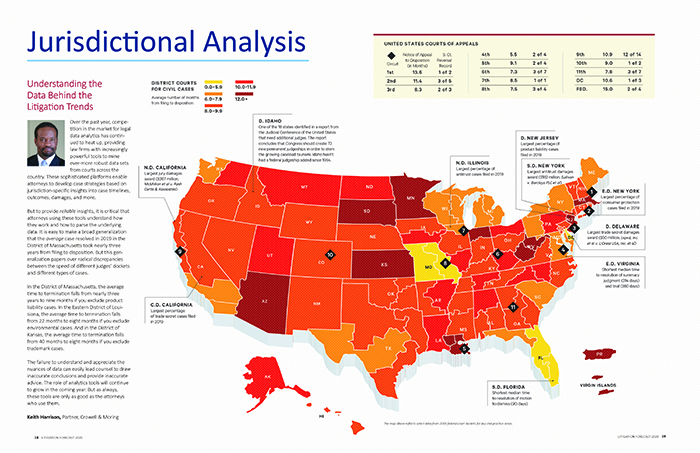Jurisdictional Analysis – Understanding the Data Behind the Litigation Trends
Publication | 01.22.20
[Article PDF]
Over the past year, competition in the market for legal data analytics has continued to heat up, providing law firms with increasingly powerful tools to mine ever-more robust data sets from courts across the country. These sophisticated platforms enable attorneys to develop case strategies based on jurisdiction-specific insights into case timelines, outcomes, damages, and more.
But to provide reliable insights, it is critical that attorneys using these tools understand how they work and how to parse the underlying data. It is easy to make a broad generalization that the average case resolved in 2019 in the District of Massachusetts took nearly three years from filing to disposition. But this generalization papers over radical discrepancies between the speed of different judges’ dockets and different types of cases.
In the District of Massachusetts, the average time to termination falls from nearly three years to nine months if you exclude product liability cases. In the Eastern District of Louisiana, the average time to termination falls from 22 months to eight months if you exclude environmental cases. And in the District of Kansas, the average time to termination falls from 40 months to eight months if you exclude trademark cases.
The failure to understand and appreciate the nuances of data can easily lead counsel to draw inaccurate conclusions and provide inaccurate advice. The role of analytics tools will continue to grow in the coming year. But as always, these tools are only as good as the attorneys who use them.

- N.D. California — Largest jury damages award ($267 million, McMillion et al v. Rash Curtis & Associates).
- C.D. California — Largest percentage of trade secret cases filed in 2019.
- D. Idaho — One of the 18 states identified in a report from the Judicial Conference of the United States that need additional judges. The report concludes that Congress should create 73 new permanent judgeships in order to stem the growing caseload tsunami. Idaho hasn't had a federal judgeship added since 1954.
- N.D. Illinois — Largest percentage of antitrust cases filed in 2019.
- D. New Jersey — Largest percentage of product liability cases filed in 2019.
- S.D. New York — Largest antitrust damages award ($182 million, Sullivan v. Barclays PLC et al).
- E.D. New York — Largest percentage of consumer protection cases filed in 2019.
- D. Delaware — Largest trade secret damages award ($50 million, Liawd, Inc. et al v. L'Oreal USA, Inc. et al)
- E.D. Virginia — Shortest median time to resolution of summary judgment (314 days) and trial (380 days).
- S.D. Florida — Shortest median time to resolution of motion to dismiss (90 days).
Contacts
Insights
Publication | 11.24.25
Litigation Funders Looking to Invest in Law Firms Face Hurdles
Publication | 11.19.25
Who Can Fix It? Antitrust, IP Rights, and the Right to Repair
Publication | 11.14.25
Three Steps Tech Companies Can Take Today To Prepare To Ride A Blue Wave In 2026



